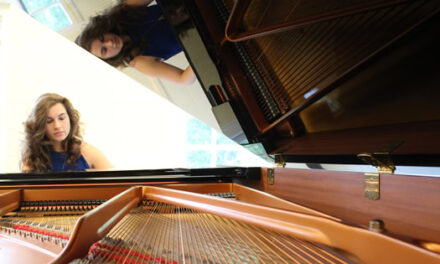According to guest cellist Michael Kannen, the “Goldberg” Variations by J.S. Bach (BWV 988) constitute “one of the cornerstones of the piano literature,” as well as “one of the wickedly difficult piano pieces” to play. Why would a cellist be describing a keyboard piece? Because he and a violinist and a violist were about to play a string trio transcription of Bach’s famous work by a well known violinist and arranger, Dmitry Sitkovetsky, conductor of the Greensboro Symphony.
The concert was the second “Dressed Down” program in the Four Seasons Chamber Music Festival. The performers were violinist and East Carolina University faculty member Hye-Jin Kim, violist and Four Seasons Festival artistic director Ara Gregorian, and cellist Kannen, a frequent Four Seasons Festival guest performer who is on the Peabody Conservatory faculty. Presented to a nearly-full house at Fletcher Recital Hall, the concert combined dazzling music by Bach with dazzling playing by the trio, based on dazzling scoring by Sitkovetsky, as written 30 years ago.
In fact, as terrific a set of compositions as the Goldberg Variations are, and as terrific a reading as the Variations received from Ms. Kim, Gregorian and Kannen, Sitkovetsky was in some respects the absent star of the evening.
The Variations consist of 30 sections, sandwiched between an opening and a closing aria. Every third section is a canon (nearly all of them recognizable as such), with fugues and dances also in the mix. Most are scored for all three players in the trio, but some are scored all or in part for duets. The cello often takes the role of a continuo when the violin and viola engage in prominent duets. As Kannen also explained, each section is written in 32 bars, some under a minute long, others at least three minutes long.
Unlike the earlier “Dressed Down” program, all the explanation of the music came at the outset of the concert, and once the music began, it continued to the end. Kannen was a most gracious and genial host, with easy-to-understand explanations that likely were quite accessible for the younger members in the audience.
The players were in top form throughout, despite the length of the program – more than one hour. Ms. Kim, as usual, played with warmth and elegance, often as the lead instrument, but Gregorian matched her with similar warmth and elegance in a lower voice. Kannen delivered the foundation of the music expertly and he seemed to enjoy himself thoroughly.
Several sections were standouts: the lively gigue in the seventh section, for example, with violin and cello combining for a spirited dance, or the final variation, labeled “Quodlibet,” a vigorous return to the main theme of the entire piece. But some of the sections contained their own highlights within highlights. The way the players handled the score as a full ensemble before dividing into solos or duets, often handing a melody line off to one another, was excellent. The frequent dialog between Ms. Kim and Gregorian, whether played in slower tempo or played with lightning-fast fingering, was quite good, and the pizzicato playing in the 19th variation was delightful – a bowed violin played over plucked cello and plucked viola here, the violin and viola alternating between plucked and bowed scoring there.
The musical moods within the Variations amplified the enjoyment by all. Some sections were quite lively; even exciting, and some were somber, even melancholy (though not sad). The lighter moments were joyful and joyfully played; the heavier moments were serious without being too heavy. And one thinks that Sitkovetsky’s arrangement of the music for three different instruments helped in no small measure to bring out the contrasts that might be subtler to the ear in a single keyboard version.
This was a musical performance to treasure on at least two levels: the compositional genius of Bach and the performing skills of Ms. Kim, Kannen, and Gregorian, who himself has arranged music for different instrumentation. But part of the real enjoyment of the program can be attributed to the way in which Sitkovetsky took an already-magnificent piece for solo instrument and turned it into a magnificent piece for string trio.











